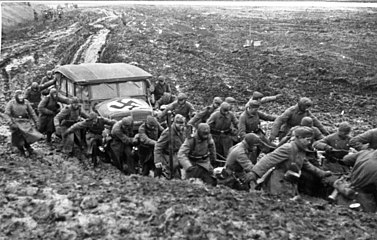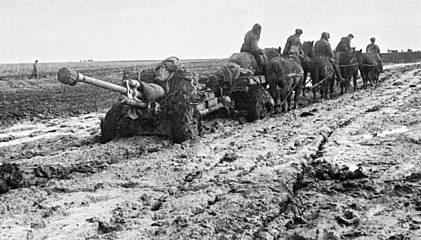泥濘期

泥濘期(でいねいき、ロシア語: распу́тица, ラテン rasputitsa; IPA: [rɐsˈputʲɪtsə]、ラスプティツァ[注 1])は、 舗装されていない道路が春の雪解けや秋雨によって[1]泥沼[2]状態になって移動や国土の横断が困難になる季節。ロシア語の"распутица"は、泥濘期の悪路[3]やぬかるみ[2]もさす[1][注 2]。
語の成り立ちと同義の表現
[編集]"распу́тица"は、語根からみると「道路」「道」あるいは「旅する」を意味する語幹の"путь" (/putʼ/) に、「食い違い」や「相違」を意味する接頭辞の"рас-" [注 3] (/ʀas/) と、女性名詞での縮小語尾の"-ица" (/it͡sə/) とが付け加わって成り立っている。ロシアでは、この語は1年の中で、春と秋とに2度、言及されることになり、その時季の道路状況をもさす[5]。
ウクライナでは同様の語として、бездоріжжя (![]() 発音) が、通常は春に用いられ、時に秋に用いられることもある。未舗装路、走行跡、小道、あるいは排水不良なオフロード域で雨や融雪が、道路を通行不能な深い泥濘に変える時季をいう[6]。
発音) が、通常は春に用いられ、時に秋に用いられることもある。未舗装路、走行跡、小道、あるいは排水不良なオフロード域で雨や融雪が、道路を通行不能な深い泥濘に変える時季をいう[6]。
同様の語は、スウェーデン語に"menföre"(「上手くない」の意)、フィンランド語に "kelirikko" (「道路が壊れた状態」の意)がある。ともに舟でゆくには水が凍り過ぎているが、徒歩や他の乗り物で渡るには十分な強さは無いような場合も当てはまる。また、東フィンランド方言に借用語で"rospuutto" (IPA: [ˈrospuːtːo])があり、ロシア語の"rasputitsa"と同様の用い方をする[7]。
影響
[編集]平時
[編集]
この語は、ベラルーシ、ロシア、それにウクライナで、泥濘化した道路状態をさし、それはこの地域の土地が粘土が積層した土壌からなり、水はけが悪いことによって引き起こされる。この時期にはロシアの特定の地域では、道路は重量制限や通行止めの対象になったりする。20世紀初頭のソ連では農村の4割に舗装道路が通じていなかったためにこの現象が障害となっていた[5]。
ウクライナやロシア南部に広く分布する土壌であるチェルノーゼムと泥濘期のぬかるみを関連付ける言説もある[8][9]。
戦時
[編集]
ロシアにおける"rasputitsa"は、 戦時においては防衛上の利点としてよく知られている[10]。それ故に「泥将軍」[注 4]や「泥元帥」といった愛称で広く語られることもある。13世紀のモンゴルのルーシ侵攻の際、おそらく春の融雪は征服や略奪からノヴゴロドを救ったと考えられている[注 5]。1812年のフランスのナポレオンのロシア遠征においても、この泥は大いなる障害であった[10]。
第二次世界大戦中の欧州の東部戦線で、数か月に渡る泥濘期は、モスクワの戦い(1941年10月~1942年1月)の間、ナチス・ドイツのソ連への進撃を遅らせ、ドイツ軍のモスクワ占領からソ連の首都を救うのに役立った可能性がある[注 6]。電撃戦という軍事ドクトリンの登場により戦車が夏や冬に作戦上の効果を発揮し易い一方で、鉄道輸送網が本領を発揮する春や秋[注 7]にはあまり役には立たない欠点も露呈した[注 8]。
2022年のロシアのウクライナ侵攻に先立ち、一部の専門家は、春の大規模な侵攻の障害となりうるものとして泥濘期の兵站上の課題を指摘していた[11]。ロシアが国境を越え戦端を開いた時、多くの機動部隊が戦場となった原野と限られた主要道で立ち往生したことで、ウクライナ側の抵抗に加え兵站の問題が生じキーウその他地域へのロシア軍の進出が明確に遅延した[12][13][注 9]。
ギャラリー
[編集]-
東部戦線で泥の中から車を押し出すドイツ国防軍の兵士。1941年10月。
-
泥濘期のぬかるみから車両を引き出すドイツ国防軍の兵士。1941年11月。
-
モスクワ近郊の村の通り。1941年11月。
-
第一次ルジェフ=スィチョーフカ攻勢で泥濘の中を馬を使って砲を移動する赤軍砲兵。1942年10月1日。
-
泥濘でスタックするサイドカー付きバイクの兵。1943年3月21日。
脚注
[編集]注釈
[編集]- ^ カタカナ転写での表記揺れとして、ラスプーチツァ、ラスプティッツァ、ラスプーチッツァ、ラスプーティツァ、ラスプチツァとも。
- ^ 一部の日本語メディアは、ぬかるみ期の表現を用いる[4]。
- ^ "раз-"も参照。
- ^ 冬将軍も参照。
- ^ May (2016), p. 65によると、"During the Mongol invasion of the Rus' principalities in 1238–1240, Novgorod escaped destruction by the Mongols due to an early spring, which transformed the routes to Novgorod into a muddy bog."(日本語訳例:ルーシ公国への1238年から1240年にかけてのモンゴルの侵攻の間、ノヴゴロドへの経路を泥質のボグへと変化させた早春期がためにノヴゴロドはモンゴルによる破壊を免れた。)
- ^ Overy (1997), pp. 113–114によると、"Both sides now struggled in the autumn mud. On October 6 [1941] the first snow had fallen, unusually early. It soon melted, turning the whole landscape into its habitual trackless state – the rasputitsa, literally the 'time without roads'.... It is commonplace to attribute the German failure to take Moscow to the sudden change in the weather. While it is certainly true that German progress slowed, it had already been slowing because of the fanatical resistance of Soviet forces and the problem of moving supplies over the long distances through occupied territory. The mud slowed the Soviet build-up also, and hampered the rapid deployment of men and machines."(日本語訳例:両陣営はまさに秋の泥の中でもがいていた。(1941年)10月6日、通常より早く初雪が降り、すぐに溶けて風景全体をいつもの轍走路が消えた状態ーラスプティツァ、即ち文字通り「道路喪失期」へと変えた。(中略)ドイツは天候の急変のためにモスクワを落とせなかったとするのが一般的である。こうしてドイツの侵攻の速さが鈍ったことが確かであるが、ソ連軍の執拗な抵抗や占領地を経る長距離の物資輸送の問題により侵攻は既に減速していた。泥はソ連の戦線構築を遅らせ、兵と兵器の早期の展開を妨げもした。)
- ^ Willmott (1989), p. 153によると、"While the Germans were to blame many factors, and particularly the rasputitsa, for the failure of Operation Taifun, the fact was that logistically the German attack on Moscow was in difficulty before it even began. German rail and road facilities were not sufficient to sustain the offensive beyond Smolensk [...]."(日本語訳例:ドイツ人はタイフーン作戦の失敗を様々な要因のせいにし、特に泥濘期のせいにした。兵站上、泥濘期が始まる前までのモスクワへのドイツの攻撃は難しかったことは事実である。ドイツの鉄道と道路の供給網はスモレンスクを越えての攻勢を維持するのには十分ではなかった。(後略))
- ^ Pinkus (2005), p. 214によると、"By the time the Germans approached their major objectives such as Rostov, Moscow, or Leningrad the campaigning season was over and Barbarossa was off his horse. [...] [Hitler] had not planned to fight in Russia during the fall and winter. He had stated in his Directive No. 21 that this was to be a 'lightning campaign' to be won in two to four months maximum. [...] the cause of failure was the proposition that the Soviet Union could and would be defeated in a blitzkrieg."(日本語訳例:ドイツの攻勢が主要な目標であったロストフ、モスクワ、レニングラードに到達するまでには、戦役に適した時期は終了し、バルバロッサは馬を降りていた〔訳注:バルバロッサ作戦参照〕。(中略)ヒトラーはロシアで秋と冬に戦う計画はしていなかった。彼は指令第21号で2から最大4ヶ月で勝利を収める「稲妻作戦」であると述べていた。(中略)失敗の原因は、ソ連が電撃戦で敗れる可能性、敗北するだろうという設定の提示にあった。)
- ^ キーウのロシア軍車列も参照。
出典
[編集]- ^ a b 中澤ほか (2015)「распутица」
- ^ a b 『泥濘』 - コトバンク
- ^ распутица < ロシア語辞書
- ^ ロシア軍がザポリージャ戦線に追加要塞、「ぬかるみ期」控え徹底抗戦か…イギリス分析 : 読売新聞(2023/10/07)
- ^ a b Siegelbaum 2011.
- ^ Hambling, David (2022年4月12日). “Mud season in Ukraine leaves Russian tanks stuck in more”. The Guardian. 2023年3月26日閲覧。
- ^ Joki, Leena (June 2011). “Mihin asti ilmoja piisaa?” (フィンランド語). Kielikuulumisia (Kotimaisten kielten keskus) (3/2011). オリジナルの28 November 2021時点におけるアーカイブ。 28 November 2021閲覧。.
- ^ Meaning ‘General Winter’ for vehicle operational capabilities in Ukraine
- ^ 60億人の食糧を支えるスゴい土「チェルノーゼム」がウクライナに集中する3つの理由 - 山と溪谷オンライン
- ^ a b Thiers 1864, p. 243.
- ^ “Will Ukraine's muddy ground halt Russian tanks?”. The Economist. (7 February 2022) 5 March 2022閲覧。
- ^ Roza, David (2 March 2022). “'Tanks and mud are not friends' – Ukraine's terrain is proving to be a problem for Russian armor”. Task & Purpose. 5 March 2022閲覧。
- ^ “Ukraine: Why has Russia's 64km convoy near Kyiv stopped moving?”. (4 March 2022) 5 March 2022閲覧。
参考文献
[編集]- Thiers, M. Adolphe (1864). History of the Consulate and the Empire of France under Napoleon. IV. Philadelphia: J. B. Lippincott & Co. "whilst it was almost impossible to drag the gun-carriages through the half-frozen mud" (regarding November 20, 1812)
- Willmott, H. P. (1989). The Great Crusade: A New Complete History of the Second World War (revised ed.). Washington, D.C.: Potomac Books, Inc. (2008発行). ISBN 9781597971911
- Overy, Richard (1997). Russia's War. London: Penguin. ISBN 1-57500-051-2
- Pinkus, Oscar (2005). “Death of Barbarossa”. The War Aims and Strategies of Adolf Hitler. Jefferson, North Carolina: McFarland. p. 241. ISBN 9780786420544
- Siegelbaum, Lewis H. (2011). Cars for Comrades: The Life of the Soviet Automobile. Ithaca: Cornell University Press. ISBN 9780801461484
- 『プログレッシブ ロシア語辞典 PROGRESSIVE РУССКО-ЯПОНСКИЙ СЛОВАРЬ』中澤英彦(編集主幹)、小学館、2015年。ISBN 9784095102719。
- May, Timothy Michael, ed (2016). The Mongo l Empire: A Historical Encyclopedia. Empires of the World. 1. Santa Barbara, California: ABC-CLIO. ISBN 9781610693400
- ジェファリー・P・メガーギー「破滅の拒絶 ドイツ統帥部とソ連における攻勢の失敗1941年秋」『紛争の想定外の拡大(令和元年度戦争史研究国際フォーラム報告書)』防衛省防衛研究所、2020年9月、83-95頁。ISBN 978-4-86482-085-1。
- Olsen, Julia; Nenashevac, Marina; Hovelsrud, Grete K. (2020-10-04). “‘Road of life’: changing navigation seasons and the adaptation of island communities in the Russian Arctic”. Polar Geography 44 (2021 issue 1): 1-19. doi:10.1080/1088937X.2020.1826593.
関連項目
[編集]外部リンク
[編集]- 地理歴史(地理総合)102-86 (7) - ウェイバックマシン(2023年3月28日アーカイブ分)
- The return of 'rasputitsa' and what it means for Russia's war in Ukraine - Yahoo News(2022年8月18日)
- ウクライナに「冬将軍」もうすぐ到来 秋雨から泥濘→凍れる大地へ ロシア軍どうする? | 乗りものニュース(白石光、2022年10月22日)
- ロシアへの抗戦奏功!? ウクライナ戦況異変と懸念 | 日曜スクープ | BS朝日(2022年3月20日)
- ウクライナの「泥濘地獄」に攻めたロシア なぜ? 知らぬはずはない“肥沃な大地の罠” | 乗りものニュース(白石光、2022年3月27日)
- なぜロシア軍は「ドロ道」に苦戦? ウクライナ軍事侵攻に見る「泥濘」での「タイヤの重要性」とは | くるまのニュース(2022年4月1日 瓜生洋明)
- 【小泉悠×山下裕貴】ウクライナ反転攻勢を「軍事地理学」で分析!独自取材“泥ねい期”の実態…両軍の戦術とは【深層NEWS】 - YouTube(2023年10月3日放送) - BS日テレ「深層NEWS」






